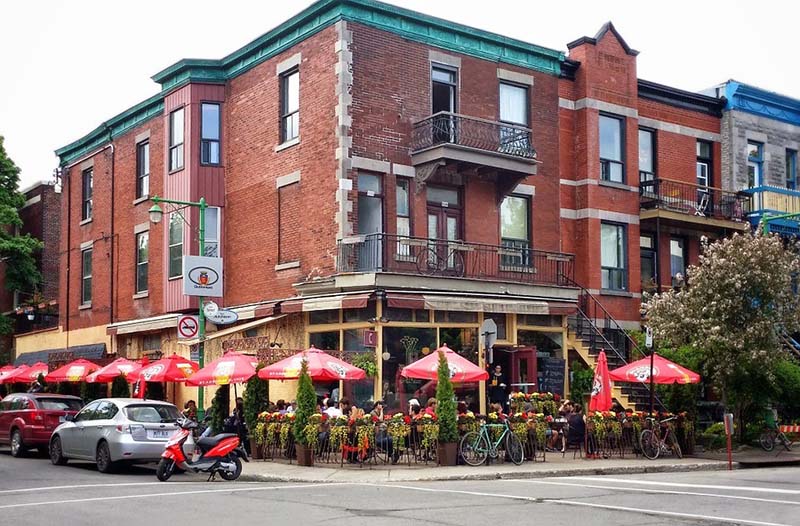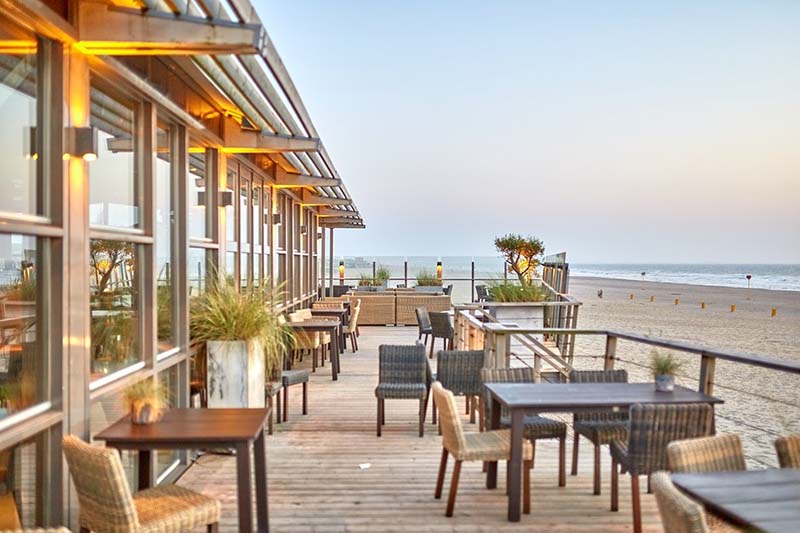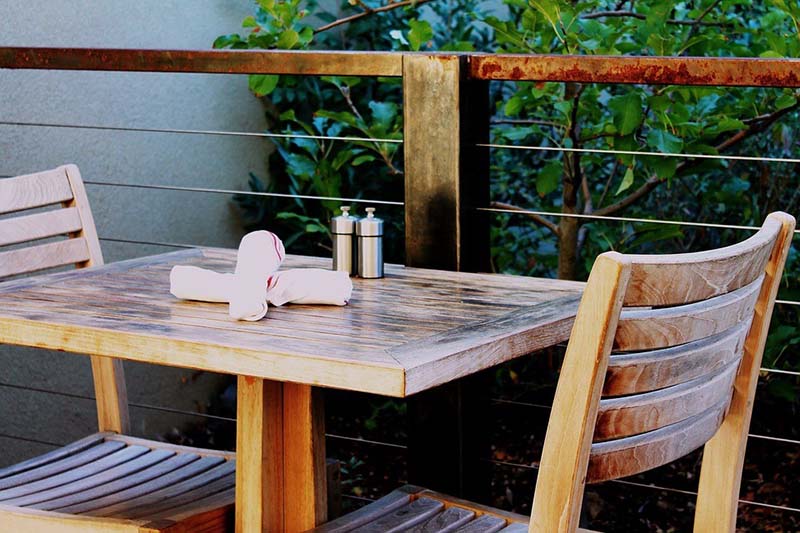- Mon-Fri 9am-4pm EST
- 888-663-4621
One of the most profitable additions a business can make is an outdoor patio. A well-planned space can raise tabs and increase traffic, and provide an additional revenue stream, too.
Of course, there's a lot that goes into creating commercial outdoor space. To get you started in the right direction, let's look at the different aspects of patio construction and how one might benefit your business and customers.

Patios are popular: whether it's an open air party zone, a candlelit evening spot, or a family setting, a well-done patio is memorable and makes for great word-of-mouth advertising.
Here are some benefits a patio can bring your business.
Customer Satisfaction
A patio promotes a friendly, relaxed feeling among patrons. Happy customers talk: giving them a new party destination or cozy nook gives them something nice to say.
Marketability
Patio happenings are public events, and announcing them is a simple and authentic way to keep your restaurant's name in the public eye. Marketing can begin while you're still in the building stages ... and never has to stop.
Economical Floor Space
Outdoor patios are a budget-friendly option for increasing your seating space. Building a patio isn't necessarily cheap, but it's much less expensive than adding indoor space. A patio gives you seating flexibility for busy times without a lot of overhead.
Customer Increase
A well-received patio brings in business through the best advertising: word-of-mouth. Patios are a pleasant backdrop that patrons seek out—and, once popular, they can handle a crowd.
Higher Tabs
The casual and social atmosphere of a patio promotes a relaxed crowd and higher returns.
Party Rentals
Hosting private functions is a great way to generate income from your patio through rental fees, sales and tips for your staff. Also, patrons who use the service—or who even know about it—will have another tie to your establishment.
Attract a New Crowd
Opening an outdoor space is an excellent way to pull in a new crowd and re-energize your audience. You can tailor your patio's style and amenities to attract a different kind of patron than your usual clientele.

Before you get too far into planning, check to make sure the idea is feasible.
An important first step is to confirm the kind of patio you'd like to build is legal in your area. This extends to both the construction phase and use afterwards: make sure you can sell food and provide seating in the space you're creating. Also check the noise regulations.
Although a patio can boost profitability for the restaurant through better ambiance, it's best if it can also provide its own revenue stream. This will help focus your investment as you go forward.
The benefits can be great, and a patio can help the bottom line for many establishments--but not all. Some areas can't support a new patio, and some spaces aren't habitable enough to be attractive.
Amazing things can be done with oddball corners to create unique outdoor—or quasi-outdoor--patio spaces. Reality comes into play, however, so make sure you have a suitable spot for your plans. Low ceilings, poor ventilation, smells, noise—there are some obstacles that can't reasonably be overcome.
Even if you can't get your dream patio, consider what you can do in the area you have available. Maybe a full-service bar and grill can't fit in the windowless basement beside the boiler, but with air conditioning and paneling it might turn a profit as spare seating for laptop campers.
Think about how your current staff might handle the new space, and whether you'll need to bring in new people. You want the savvy veterans to be supportive, and don’t want to lose over-stressed employees when they're most needed.

Patios come in infinite varieties, but there are some useful categories for planning. Here's a rundown of the main types in order of expense and effort:
Sit-down Space
Perhaps your space isn't suitable for crowds or mainstream dining--it might still be useful for overflow seating. Creating a comfortable area for patrons that can be served by your existing facilities and staff may be a win-win expansion with little risk.
Service Station
Another option is a patio service station for beverages and ice. Perfect for social gatherings, a service station avoids the expense and overhead of a full kitchen or bar.
Service stations are great amenities for rental space for parties and conferences. You can install standalone soda and beer taps if you need more capacity. A standing station is also useful for catered affairs, and can double as a wait station for easier table busing.
Full-Service Kitchen or Bar
You can recreate almost another kitchen for your patio, if it makes sense for your business. Offering a room with dedicated facilities lets you create a special mood and atmosphere.
Full-Service Bar - A bar kicks the patio experience up a party notch or so, and can bring in extra business from regulars, too. It's also great for giving waiting-list diners a place to socialize—and consume—in the meantime.
Think this through, because serving alcohol can change the character of your establishment and attract a different crowd. Make bar service changes with awareness of your goals and customer base.
Outdoor Grilling - Adding cooking facilities to a patio is a customer-friendly way to be memorable. Instead of duplicating a complete kitchen, many patios limit their cooking to grilling and other open-air methods.
Cooking food in the presence of diners also encourages trust by allowing them to watch the meal's preparation.

If you want steady business, your patio has to have weatherproofing. You generally need good flooring and drainage and a sound roof, though there is wiggle room if you're planning a fair-weather patio.
Conditioning
Nothing kills off a patio vibe quicker than uncomfortable temperatures, hot or cold. Fans and space heaters may do the trick (but check building codes). For an upscale setting, central air and heat is usually best.
Pests
Bugs want to become part of the patio experience, and it’s your job not to let them. You can't fumigate or use misters around consumables, but there are industrial bug-zappers and wafting incense to sow discouragement. Pest control is an ongoing expense to plan for.
Flooring
This is a foundational decision in more than one way, as you can greatly affect the vibe of a patio with the right—or wrong—flooring. Brick, wood, tile, gravel, flagstone, marble, and the infinite world of poured concrete and concrete pavers: each material has its own level of durability, attractiveness, style … and cost.
Décor
The fun part where creativity takes center stage is in planning the décor. Some popular schemes are tropical groves, period antiques, and historical eras. A tasteful space always attracts a crowd.
Furnishings
The furniture, plants, and other patio hardscape must be comfortable and complementary, and must hold up to the conditions. Durable and easily cleaned fabrics over water-resistant construction are needed in an outdoor setting.
Lighting
Another key element for setting the mood. The right light configuration can evoke a friendly, seclusive, or dramatic feel to a space. Be sure to check local regulations, as some areas have restrictive lighting ordinances.
Rolling Menu Board
One seeming detail that looms large for the diner is the menu. Patios with exposure to the elements present a challenge; flapping menus on a windy table is an obvious concern. Handwritten "chalk" boards don't weather well, and wall menus detract from the casual feel (and don't let you change the specials).
If you have an open patio, consider using a rolling menu board. It looks distinctive and is easy to update, and can be rolled to a sheltered spot in off hours.
It's not a question of whether building a new outdoor patio for your business will face regulatory red tape. It will. Fortunately, there are steps to ensuring your patio stays within the lines.
Start with your landlord, if you're leasing. They can stop your project with a simple refusal. The most common objection is increased liability, which you can answer by guaranteeing coverage with increased insurance … or by presenting evidence of an expected boost in the property's value.
When having your blueprints drawn up, you'll need to take the increased seating capacity into account. You'll need a fire escape plan. Insurance is critical, so you'll need to contact your business's rep to plan ahead for the new patio space. You may need to expand coverage, or find a new insurance plan to get the best deal.
If your project is green-lighted by your primary stakeholders, get your wallet ready for the orbiting constellation of concerned authorities. If you don’t file the right paperwork, it could be even more expensive down the road. Be prepared.
Permits – Contact your local zoning commission to find out which permits you need. You may need separate applications for electricity and plumbing work.
Health Codes – You'll probably need a health inspection of the new space, especially if you are serving food. Contact your Health Department for the compliance regulations in your area and to schedule an inspection. Also find out the rules about smoking, and the legal situation involving patrons and dogs.
Sidewalk Fees - Some locales charge an outdoor seating fee for use of public sidewalks, and more cities are adopting this approach.
Alcohol Sales – Your business will likely be subject to licensing and regulations involving sales of alcohol outdoors. Some states have greater regulation than others; check with your local jurisdiction.
The final phase to think through is what happens once the patio is operational.
Advertising
People will eventually find out about your awesome new patio by word-of-mouth, but you can speed the process and start generating income more quickly with advertising. Budget it in!
Promotions
Patios are a promotion generator: you can get steady mileage in promotional offers throughout its life. Just offer a half-priced item in celebration of anything: "On Our Famous Patio!" Done.
Some of the best promotional opportunities happen before the opening of your new space. Plan ahead to take advantage of the twin peaks of consumer attraction: anticipation and novelty.
Scents
One of the big selling points of cooking on an open-air patio is the smell. Delicious cooking odors are one of the best forms of advertising known. Take advantage of this if you can.
A well-designed, comfortable patio can be a great asset for your restaurant, both for the friendly, relaxed atmosphere and the additional business it generates. It worthwhile to size up your spare footage and evaluate it for patio potential.
Success is not guaranteed, of course. Planning is the key to making the project a success—and, just as important, to avoid pressing ahead with an unworkable idea.
Restaurants strive to stand out from the pack, and patio space is a great way to do it. In the right situation, a commercial patio can promote good times for your customers—and for your business, too.
You must login to post comments.